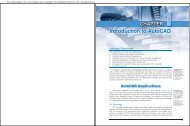Chapter 1 - Goodheart-Willcox
Chapter 1 - Goodheart-Willcox
Chapter 1 - Goodheart-Willcox
Create successful ePaper yourself
Turn your PDF publications into a flip-book with our unique Google optimized e-Paper software.
32 <strong>Chapter</strong> 1 A Close-Up View of You<br />
1-8 Down syndrome results when a child inherits an<br />
extra chromosome. One of the effects of this condition is<br />
mental retardation.<br />
Genetic Counseling<br />
Genetic counselors help people understand<br />
how hereditary diseases and disabilities are<br />
passed on. Some people may already know that<br />
a hereditary condition exists in their family.<br />
Couples who have a child with an inherited<br />
disease may want to seek genetic counseling<br />
before having more children. Also, couples<br />
related by blood may want to seek genetic<br />
counseling before having a family.<br />
Your family tree is a list of your blood<br />
relatives for several generations. By tracing your<br />
family tree, you can identify conditions that could<br />
be hereditary in your family. By checking the life<br />
span of past generations, you can determine the<br />
average life span in your family. You can also<br />
trace other dominant or recessive traits that are<br />
passed from one generation to the next.<br />
Medical Research Versus the<br />
Right to Privacy<br />
New technologies make it possible to gather<br />
information about each person. This ability<br />
raises some concerns about the welfare of private<br />
citizens. For instance, if you have a genotype<br />
similar to a person with Alzheimer’s disease,<br />
would you want to know this? Would you want<br />
your insurance company, your employer, or<br />
others to know? Could such information lead to<br />
discrimination?<br />
Concerns for the personal well-being of<br />
individuals must be considered. The ability to<br />
use a technology to gather such information must<br />
be weighed against a person’s right to keep the<br />
information private and confidential. Such issues<br />
will continue to be raised as technology becomes<br />
more advanced.<br />
Review Section 1:2<br />
1. Name five characteristics that a person inherits.<br />
2. Explain the difference in the effects of a<br />
dominant gene and a recessive gene on the way<br />
a trait is expressed.<br />
3. Describe how the use-it-or-lose-it rule applies to<br />
brain development.<br />
4. Explain why a marriage between close relatives<br />
is a health risk.<br />
5. Under what circumstances might a couple seek<br />
genetic counseling?<br />
section<br />
1:3<br />
Environment<br />
Sharpen Your Reading<br />
Add to the graphic organizer you prepared<br />
for Section 1:2. Include branches listing the<br />
environmental factors that affect growth and<br />
development. Add the heading Environmental<br />
Factors.<br />
Boost Your Vocabulary<br />
Find or draw pictures illustrating each of the key<br />
terms.<br />
Know Key Terms<br />
environment<br />
sibling<br />
cultural heritage<br />
peers<br />
technology<br />
media<br />
resiliency<br />
Your environment includes everything in<br />
your surroundings, 1-9. Family, friends, home,<br />
and school are part of your environment. Your<br />
senses of seeing, feeling, hearing, smelling,<br />
and tasting bring you information from your<br />
environment. All these factors influence your<br />
experiences.<br />
Both heredity and environment influence<br />
personal development. You inherit certain traits<br />
that affect the way you look and behave, but<br />
then your environment takes over. Your heredity<br />
Section 1:3 Environment 33<br />
determines your potential for development. Your<br />
environment determines if or how that potential<br />
is reached.<br />
The Influence of the<br />
Family Environment<br />
The family is usually the major human<br />
influence in a person’s life. This is especially true<br />
during the preschool years, when children spend<br />
most of their time with parents, grandparents, or<br />
other family members.<br />
Most families want to provide a nurturing<br />
environment in which children feel secure and<br />
protected. Physical needs for food, clothing, and<br />
shelter are met. A child’s needs to be with people<br />
and to give and receive love are met. Children<br />
also have opportunities to learn, explore, and<br />
create. In such an environment, family members<br />
can grow and develop to maturity.<br />
The Prenatal Environment<br />
The prenatal environment is the child’s<br />
surroundings before birth. The way a woman<br />
cares for herself during pregnancy will affect<br />
her baby. Eating properly and avoiding harmful<br />
drugs and medications are healthful practices.<br />
Good health increases a woman’s chance of<br />
having a healthy baby.<br />
•<br />
•<br />
•<br />
•<br />
•<br />
•<br />
•<br />
•<br />
•<br />
Environmental Factors<br />
Family<br />
Cultural heritage and society<br />
School<br />
Peers<br />
Community<br />
Religion<br />
Technology<br />
Media and electronic entertainment<br />
Stress and violence<br />
1-9 Many factors in the environment influence your<br />
growth and development.

















